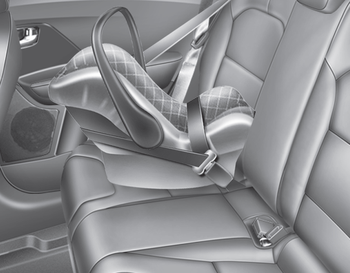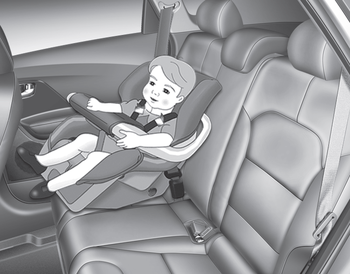Kia Niro: Selecting a Child Restraint System (CRS) / Child Restraint System types
There are three main types of Child Restraint Systems: rearward-facing, forward-facing and booster Child Restraint Systems.
They are classified according to the child’s age, height and weight.
Rearward-facing Child Restraint System

A rearward-facing Child Restraint System provides restraint with the seating surface against the back of the child. The harness system holds the child in place, and in an accident, acts to keep the child positioned in the Child Restraint Systems and reduce the stress to the fragile neck and spinal cord.
All children under the age of one year must always ride in a rearwardfacing Child Restraint System. There are different types of rearward-facing Child Restraint Systems: infant-only Child Restraint Systems can only be used rearward-facing. Convertible and 3-in-1 Child Restraint Systems typically have higher height and weight limits for the rearward-facing position, allowing you to keep your child rearward-facing for a longer period of time.
Keep using Child Restraint Systems in the rearward-facing position as long as children fit within the height and weight limits allowed by the Child Restraint System's manufacturer.
Forward-facing Child Restraint System

A forward-facing Child Restraint System provides restraint for the child’s body with a harness. Keep children in a forward-facing Child Restraint System with a harness until they reach the top height or weight limit allowed by your Child Restraint System’s manufacturer.
Once your child outgrows the forward- facing Child Restraint System, your child is ready for a booster seat.
Booster seats
A booster seat is a Child Restraint System designed to improve the fit of the vehicle’s seat belt system. A booster seat positions the seat belt so that it fits properly over the stronger parts of your child’s body. Keep your children in booster seats until they are big enough to fit in a seat belt properly.
For a seat belt to fit properly, the lap belt must lie comfortable across the upper thighs, not the stomach. The shoulder belt should lie comfortable across the shoulder and chest and not across the neck or face. Children under age 13 must always be properly restrained to minimize the risk of injury in an accident, sudden stop or sudden maneuver.
 Selecting a Child Restraint System (CRS)
Selecting a Child Restraint System (CRS)
When selecting a Child Restraint System for your child, always:
Make sure the Child Restraint System has a label certifying that it meets
applicable Safety Standards of your country. A Child Re ...
 Installing a Child Restraint System (CRS)
Installing a Child Restraint System (CRS)
WARNING
Before installing your Child Restraint System always:
Read and follow the instructions provided by the manufacturer of the Child
Restraint System.
Failure to follow all warnings and instr ...
Other information:
Kia Niro 2017 (DE HEV) Service Manual: General safety information and caution
Safety Precaution
Precautions to take before servicing
high voltage system
Since hybrid vehicles contain a high voltage battery, if the
high voltage system o ...
Kia Niro 2017 (DE HEV) Service Manual: Manifold Absolute Pressure Sensor (MAPS) Description and operation
Description
Manifold Absolute Pressure Sensor (MAPS) is a speed-density type sensor installed
on the surge tank. It senses absolute pressure of the surge tank and transfers the
analog signal proportional to the pressure to the ECM. By using this signal, the
ECM calculates the inta ...
